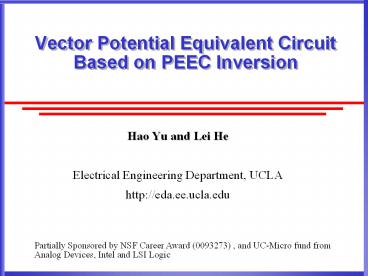Vector Potential Equivalent Circuit Based on PEEC Inversion - PowerPoint PPT Presentation
Title:
Vector Potential Equivalent Circuit Based on PEEC Inversion
Description:
Existing passivity-guaranteed sparsification methods lack accuracy or theoretical justification ... Enable various passivity preserved sparsifications ... – PowerPoint PPT presentation
Number of Views:52
Avg rating:3.0/5.0
Title: Vector Potential Equivalent Circuit Based on PEEC Inversion
1
Vector Potential Equivalent Circuit Based on
PEEC Inversion
- Hao Yu and Lei He
- Electrical Engineering Department, UCLA
- http//eda.ee.ucla.edu
Partially Sponsored by NSF Career Award (0093273)
, and UC-Micro fund from Analog Devices, Intel
and LSI Logic
2
Outline
- Introduction
- Vector Potential Equivalent Circuit Model
- VPEC Property and Sparsification
- Conclusions and Future Work
3
Interconnect Model
- de facto PEEC model is expensive
- Accurate model needs detailed discretization of
conductors - Distributed RLC circuit has coupling inductance
between any two segments
- Total 3,278,080 elements for 128b bus with 20
segments per line - 162M storage of SPICE netlist
4
Challenge of Inductance Sparisification
- Partial inductance matrix L is not diagonal
dominant - Direct truncation results loss of passivity
- Existing passivity-guaranteed sparsification
methods lack accuracy or theoretical
justification - Returned-loop ShepardTCAD00
- Shift-truncation (shell) KrauterICCAD95
- K-element DevganICCAD00
- Localized VPEC PacelliICCAD02
5
K-Element Method
- Need to extend SPICE to simulate K-element Ji
DAC01
6
Contribution of Our Paper
- Derive inversion based VPEC model from first
principles - Replace inductances with effective magnetic
resistances - Develop closed-form formula for effective
resistances - Enable direct and faster simulation in SPICE
- Prove that circuit matrix in VPEC model is
strictly diagonal dominant and hence passive - Enable various passivity preserved sparsifications
7
Outline
- Introduction
- Vector Potential Equivalent Circuit Model
- VPEC Property and Sparsification
- Conclusions and Future Work
- VPEC circuit model
- Inversion based VPEC
- Accuracy comparison
8
Vector Potential Equations for Inductive Effect
- Vector potential for filament i
ith Filament
- Integral equation for inductive effect
9
VPEC Circuit Model
10
VPEC Circuit Model
11
VPEC Circuit Model
12
Recap of VPEC Circuit Model
- Inherit resistances and capacitances from PEEC
- Inductances are modeled by
- Effective resistances
- Controlled current/voltage sources
- Unit self-inductance
- Much fewer reactive elements
- leads to faster SPICE simulation
13
Comparison with Localized VPEC
- Our solution
- Solution in localized VPEC PacelliICCAD02
(1) It is not accurate to consider only adjacent
filaments
(2) There is no efficient and closed-form formula
solution to calculate effective resistances
14
Introduction of G-Element
15
Closed-form Formula for Effective Resistance
- Major computing effort is inversion of
inductance matrix - LU/Cholesky factorization
- GMRES/GCR iteration (with volume decomposition)
Inversion Based VPEC
16
Interconnect Analysis Based on VPEC
- Calculate PEEC elements via either formula or
FastHenry/FastCap - Invert L matrix
- 3. Generate full VPEC including effective
resistances, current and voltage sources. - 4. Sparsify full VPEC using numerical or
geometrical truncations - 5. Directly simulate in SPICE
17
Spice Waveform Comparison
Full PEEC vs. full VPEC vs. localized VPEC
Full VPEC is as accurate as Full PEEC Localized
VPEC model is not accurate
18
Spiral Inductor
Non-bus Structure Three-turn single layer
on-chip spiral inductor
Full VPEC model is accurate and can be applied
for general layout
19
Outline
- Introduction
- Vector Potential Equivalent Circuit Model
- VPEC Property and Sparsification
- Conclusions and Future Work
20
Property of VPEC Circuit Matrix
- Main Theorem
- The circuit matrix is strictly
diagonal-dominant and positive-definite
Corollary The VPEC model is still passive
after truncation
21
Numerical Sparsification
22
Truncation Threshold
128-bit bus with one segment per line
- Supply voltage is 1V
- VPEC runtime includes the LU inversion
- Full VPEC model is as accurate as full PEEC model
but yet faster - Increased truncation ratio leads to reduced
runtime and accuracy
23
Waveforms Comparison
- Full VPEC is as accurate as full PEEC
- Sparsified VPEC has high accuracy for up to
35.7 sparsification
24
Geometry Based Sparsification - Windowed
For the geometry of aligned bus line
25
Geometry Based Sparsification - Normalized
- Normalized VPEC
- normalized aligned coupling
26
Geometrical Sparsification Results
32-bit bus with 8 segment per line
- Decreased window size leads to reduced runtime
and accuracy - Windowed VPEC has high accuracy for window size
as small as (16,2) - Normalized model is still efficient with bounded
error
27
Runtime Scaling
- Circuit one segment per line for buses
- The runtime grows much faster for full PEEC than
for full VPEC - full PEEC is 47x faster for 256-bit bus due to
reduced number of reactive elements - Sparsified VPEC reduces runtime by 1000x with
bounded error for large scale interconnects
28
Conclusions and Future Work
- Derived inversion based VPEC from first principle
- Shown that Full VPEC has the same accuracy as
full PEEC but faster - Proved that VPEC model remains passive after
truncation
- To work on
- Fast iteration algorithms for inversion of L
- Model-order-reduction for VPEC (see ICCAD2006)































